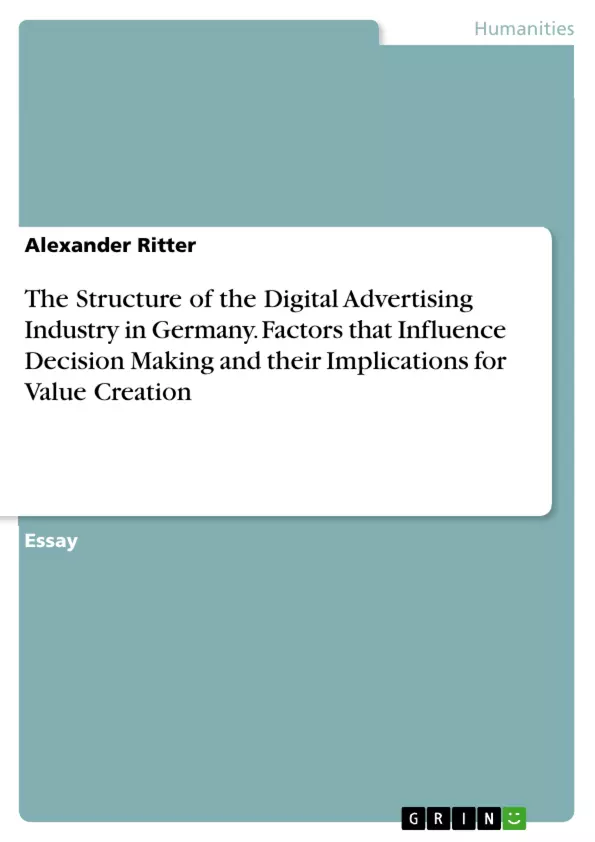This essay aims to analyze decision making in the field of digital advertising in the German market. In order to do this effectively, the structure of Germany’s digital media industry will be analyzed, with a particular focus on the relationship between companies, their agencies and third party service providers. The role of these actors with regards to the value chains of companies’ marketing efforts will be assessed. Moreover this essay aims to address the common factors that lead to inefficiencies in digital media decision making, which are often rooted in the structural relationship between the various players in the industry (e.g. asymmetry of information), the mismatch between mission statements and actual business conduct within agencies and service providers. The author will assess the possibility of ‘best practices’ in the conduct of digital media decisions and use empirical examples to which extent these decisions were aimed at maximizing the return of client investment. Finally, the author will provide normative suggestions for companies that engage or plan to engage in digital media and marketing activities that aim to improve the return of investment.
Inhaltsverzeichnis (Table of Contents)
- Introduction
- What is meant by the term 'digital advertising'?
- Structure of the industry
- Conclusion
Zielsetzung und Themenschwerpunkte (Objectives and Key Themes)
This essay aims to analyze decision making in the field of digital advertising in the German market. It will explore the structure of the German digital media industry, focusing on the relationships between companies, their agencies, and third-party service providers. The author aims to identify factors that lead to inefficiencies in digital media decision making and assess the possibility of best practices for maximizing client investment returns. The essay will also advocate for the adoption of evidence-based management principles in digital advertising.
- Decision making in digital advertising in the German market
- The structure of the German digital media industry
- Factors leading to inefficiencies in digital media decision making
- Best practices for maximizing client investment returns
- The application of evidence-based management principles in digital advertising
Zusammenfassung der Kapitel (Chapter Summaries)
- Introduction: The author introduces the topic by highlighting the prevalence of unfounded decision-making in digital advertising and the need for evidence-based management (EBM) principles. The author highlights the potential of EBM in digital advertising, but also notes that it is not widely used due to resistance to change and unawareness of its benefits. The author outlines the focus of the essay: analyzing the structural and operational inefficiencies within the digital advertising industry and advocating for the use of EBM principles to enhance transparency and improve return on investment.
- What is meant by the term 'digital advertising'? This section provides a definition of digital advertising, differentiating it from digital marketing and highlighting the most common digital advertising activities, such as search engine advertising (SEA), social media advertising (SMA), and video advertising. The significance of programmatic advertising and real-time bidding in the development of digital advertising is also discussed.
- Structure of the industry: This chapter explores the structure of the digital advertising industry, outlining the roles of different stakeholders, including advertisers, publishers, service providers (such as media agencies), and technology companies. The author discusses the complexities of the ecosystem and the implications of outsourcing digital media competencies to media agencies. The concept of a principal-agent problem, stemming from asymmetry of information between advertisers and media agencies, is introduced, setting the stage for the subsequent development of hypotheses.
Schlüsselwörter (Keywords)
Key topics and concepts explored in this essay include digital advertising, decision making, evidence-based management (EBM), digital media industry, Germany, agency-advertiser relationships, inefficiencies, value creation, return on investment (ROI), principal-agent theory, asymmetry of information, behavioral targeting, programmatic advertising, and real-time bidding.
- Quote paper
- Alexander Ritter (Author), 2016, The Structure of the Digital Advertising Industry in Germany. Factors that Influence Decision Making and their Implications for Value Creation, Munich, GRIN Verlag, https://www.grin.com/document/379638



